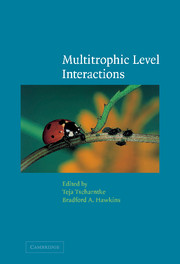Book contents
- Frontmatter
- Contents
- List of contributors
- 1 Multitrophic level interactions: an introduction
- 2 Plant genetic variation in tritrophic interactions
- 3 Multitrophic/multispecies mutualistic interactions: the role of non-mutualists in shaping and mediating mutualisms
- 4 Tritrophic interactions in tropical versus temperate communities
- 5 Endophytic fungi and interactions among host plants, herbivores, and natural enemies
- 6 Multitrophic interactions in space: metacommunity dynamics in fragmented landscapes
- 7 The chemical ecology of plant–caterpillar–parasitoid interactions
- 8 Canopy architecture and multitrophic interactions
- 9 Tritrophic below- and above-ground interactions in succession
- 10 Multitrophic interactions in decomposer food-webs
- Index
1 - Multitrophic level interactions: an introduction
Published online by Cambridge University Press: 08 August 2009
- Frontmatter
- Contents
- List of contributors
- 1 Multitrophic level interactions: an introduction
- 2 Plant genetic variation in tritrophic interactions
- 3 Multitrophic/multispecies mutualistic interactions: the role of non-mutualists in shaping and mediating mutualisms
- 4 Tritrophic interactions in tropical versus temperate communities
- 5 Endophytic fungi and interactions among host plants, herbivores, and natural enemies
- 6 Multitrophic interactions in space: metacommunity dynamics in fragmented landscapes
- 7 The chemical ecology of plant–caterpillar–parasitoid interactions
- 8 Canopy architecture and multitrophic interactions
- 9 Tritrophic below- and above-ground interactions in succession
- 10 Multitrophic interactions in decomposer food-webs
- Index
Summary
Terrestrial ecosystems are characterized by a huge diversity of species and a corresponding diversity of interactions between these species, but community ecology has historically been dominated by interactions between two trophic levels; in particular, plant–herbivore and predator–prey interactions. Only more recently have ecologists become interested in the nature of more complex interactions involving three or more trophic levels (e.g., Price et al., 1980; Bernays and Graham, 1988; Barbosa et al., 1990; Hawkins, 1994; Gange and Brown, 1997; Olff et al., 1999; Pace et al., 1999; Dicke, 2000; Schmitz et al., 2000). It has quickly become clear that a multitrophic level approach addresses the complexity of food-webs much more realistically than does the simpler approach. Our reasons for generating this book are to provide an overview of progress that has been made in demonstrating how research on more realistic models of food webs has enriched our understanding of complex biological systems, and to highlight new and particularly exciting avenues of future research in this area.
In the past two decades there has been intense interest in tritrophic interactions between plants, herbivores, and natural enemies, driven by the need both to integrate host plant resistance and biological control in the management of arthropod pests and to understand the relative importance of direct and indirect interactions in ecological communities. Many examples document the direct effects of physical, chemical, and nutritional qualities of plants on the attack rate, survival and reproduction of natural enemies.
- Type
- Chapter
- Information
- Multitrophic Level Interactions , pp. 1 - 7Publisher: Cambridge University PressPrint publication year: 2002
- 6
- Cited by

